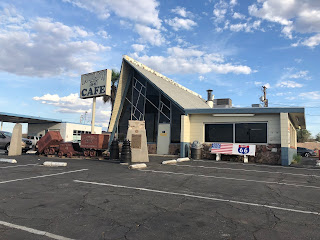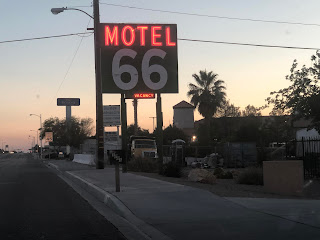In the morning, I headed north back across Joshua Tree as I had to retrace my drive about 50 miles to get back to R66 at Amboys, once again crossing the salt lake and lava flows.
 |
| Ocotillo Fouquieria splendens |
 |
| Yucca schidigera distinguished by the filaments on the leaves. They were still in flower. |
 |
| Teddy-bear cholla Cylindopuntia bigelovii |

 |
| Desert willow Chilopsis linearis |
This plant grew at the side of road in pure sand. It had a sweet, sickly smell which attracted myriad insects.

Desert milkweed Asclepias erosa
The transition between the Colorado and Mojave deserts is clear - once its been pointed out!
 |
| The Colorado is to the right; the Mojave to the left, where the rocks become fractured. |
 |
| Rock formations typical of the Mojave |
 |
| Looking north towards the Mojave from the transition zone in the Colorado. |
 |
| Joshua Tree Yucca brevifolia |
The town of Joshua Tree is just outside. The medians are planted with various cacti and other indigenous plants, as are the yards of houses. This is a beaver tail cactus Opuntia basilaris.
When taking the next picture, I noticed that a desert kangaroo rat was hiding at the base of the plant. You can just see his foot sticking out form behind the flower.
This one is for Emma. The rider of this splendid Harley was having as much trouble as I was getting the gas pumps to operate!
Driving back to Amboys, I noticed this camouflaged communications relay. Good to see that public utilities have a sense of humour, or aesthetic!
 |
| A closer view of the volcanic cone, which is a National Monument. It was formed only 10,000 years ago, which is fairly recent in geological terms. It is on the edge of the "ring of fire", of which the San Andreas fault, about 100 miles west, forms a part. |
 |
| Lava flow |
I rejoined 66 just west of Amboys. This architecturally interesting cafe is at Ludlow, a few miles north-west. Outside are old mining carts, the kind that feature in films, usually running away along underground rail-tracks.

I have never seen the film "Bagdad Cafe", made in 1989. It won a number of awards in Europe and the US. The site of the original Bagdad Cafe is now no more than a tree, according to the EZ Guide, the town disappearing with the bypassing of 66 by I40 in 1973. The current building in Newberry Springs was the former Sidewinder Cafe, where the movie was filmed, subsequently renamed. Its popularity in Europe explains the number of European signatories in the visitors' book and the crowds of young European tourists.


 |
| Evidence of the popularity of this cult destination |
 |
| European visitors leave their currency pinned to the walls. |
Anther one for Emma. On our first family trip to Vegas, many years ago, we went to the Calico Ghost Town. There were a number of large crosses on the hill behind it and Emma insisted "Look its a Graaaave!". Apparently she and her brother Pete also went to buy marbles, but didn't know about sales tax, which is never included in the price displayed (unlike VAT), and didn't have enough money. The shopkeeper, charmed by their cute British accents, handed them over anyway!
Barstow is a town at a crossroads, firstly of the railroads but also of I15, which runs north-east to Las Vegas and south-west to Los Angeles, and I40, which ends here. It is a bustling town, split in half by the Highways, with a number of old 66 motels still going strong.















No comments:
Post a Comment